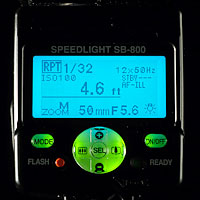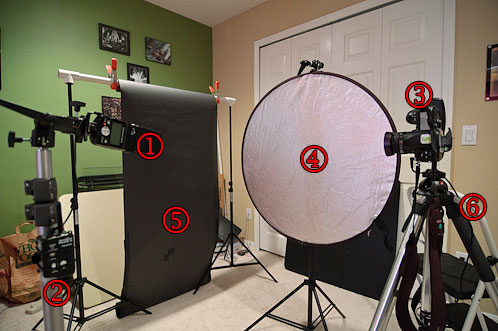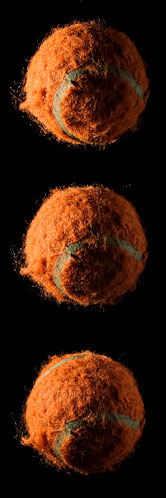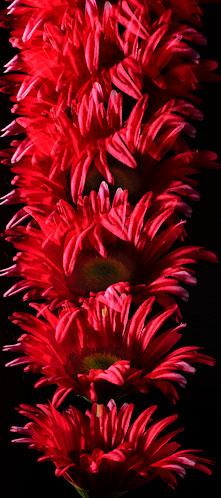Stroboscopic flash is when a series of flashes are fired continuously in a single exposure. The multiple bursts of light allow you to freeze a moving subject multiple times as it moves through the frame. The results are very similar to that of combining multiple exposures. This tutorial is a brief overview of how stroboscopic flash works.
How Do I Access Stroboscopic Flash?


Many of today’s high-end Speedlights such as the Canon 580EX/EX II and Nikon SB-800/900 have this feature built in. Canon refers to this feature as Multi Mode while Nikon calls it Repeating Flash (RPT). We’ll be using a Nikon SB-800 for this tutorial, but all of these concepts can be applied to any flash with a stroboscopic mode.
Stroboscopic flash is first controlled by the flash output, frequency, and number of frames. First, you set the power level of your flash just as you would in manual mode. Frequency, expressed in Hz, represents the number of flashes per second. The number of flashes represents exactly how many times your flash will fire at a given frequency. Keep in mind, the lower the output, the more flashes you can get at a given frequency.
Setting the Exposure
Once you have your output, frequency, and number of flashes set, you’ll need to set the exposure. You can determine the aperture by using a light meter, using the guide number table in your flash’s manual (f/stop = Guide number x ISO factor / Subject Distance), or simply by experimenting.
Keep in mind that if you have a portion of the frame overlapping (i.e. still part of the frame), the repeating flash may result in overexposure. For example: If you flash a still subject at 1/2 power two times, your exposure would be almost exactly like flashing that subject once at full power. This generally doesn’t affect moving subjects but is an important thing to consider when setting up your shot and calculating exposure.
The minimum shutter speed is determined by dividing the frequency of flashes into the number of flash frames (shutter speed = number of flashes / frequency (Hz)). For example: If your number of flashes per frame was 10 and the frequency is 5Hz, you would need a shutter speed of 2 seconds or slower. You can also use the bulb exposure if you are trying to time a particular action.
Setting Up for the Shot
Stroboscopic flash pictures work best in a dark setting. Because the shutter speeds can be very long, it’s also best to work on a tripod. You can trigger the flash from the camera’s hot-shoe, from an off-camera cable, or using a radio trigger. For this demonstration I used the latter. The main reason for this is when you fire the camera, it immediately fires the flash. By using the PocketWizard on the flash, I could delay when the flash was firing and manually trigger it as the object was in the frame. Here is a shot of the setup:


(1) Nikon SB-800 Speedlight (2) PocketWizard Plus II Transceiver with PC-sync connection (3) Camera with shutter release attached (4) Reflector on other side of “drop area” for fill (5) Black background (6) Step ladder to drop subject from.
I pre-focused to where the “drop zone” would be, and marked it on the floor with gaffer’s tape. I used a larger aperture to get a little leeway with the depth of field and to allow a longer shutter speed. Once the camera was set up and focused, I turned off all the lights and hit the shutter. I then dropped the object and triggered the PocketWizard as the subject passed through the frame. Here are the results:


Nikon D200, 35mm f/2, 3.0 sec @ f/11, ISO 100; Flash Setting: 1/32, 10x40Hz


Nikon D200, 35mm f/2, 3.0 sec @ f/11, ISO 100; Flash Setting: 1/32, 10x40Hz


Nikon D200, 35mm f/2, 3.0 sec @ f/11, ISO 100; Flash Setting: 1/32, 10x40Hz


Nikon D200, 50mm f/1.8, 3.0 sec @ f/5.6, ISO 100; Flash Setting: 1/64, 10x40Hz
You might have to do a lot of experimenting to get the results that you want, but stroboscopic flash can be a lot of fun. Hopefully the provided frequency, number of flashes, and power settings will give you a starting point.
Other Methods
There are also ways of achieving the same effect using traditional strobes or speedlights without a stroboscopic mode. You can always open the shutter and manually trigger the flash as many times as you’d like. Triggering systems like the PocketWizard Multimax transceivers feature a mode called multipop that allows a flash to trigger multiple times within an exposure.
There are also infrared and sound triggers available for high speed photography. These devices fire your flash when a particular action happens and can be a lot of fun to experiment with.
